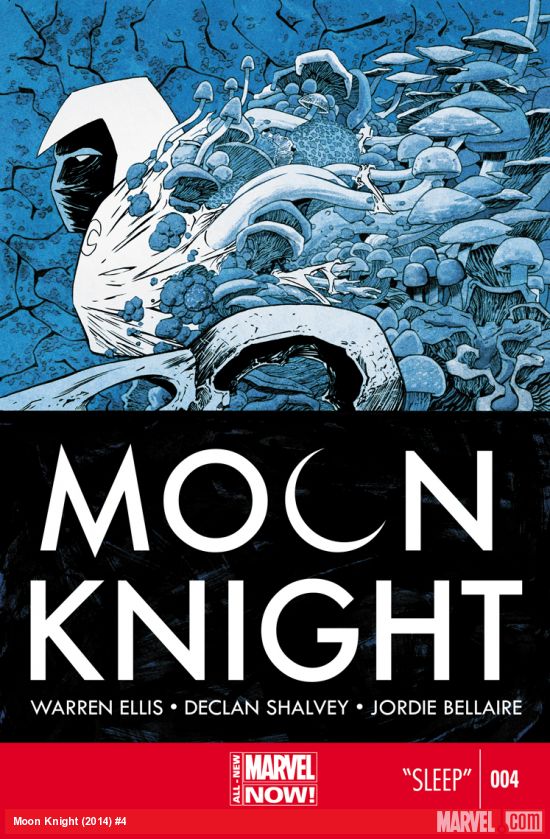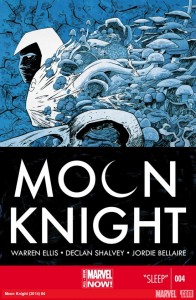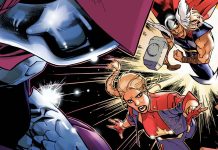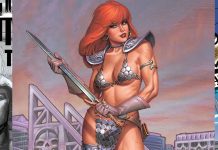What makes a comic ‘worth it?’
In the comments to my introductory column, a lot of readers seem to gauge the value of a comic by dividing the time spent consuming by the amount of money spent. There’s nothing wrong with that formula; it’s one that I use all the time myself. Under that formula, the comic I decided to purchase this week–Warren Ellis, Declan Shalvey, and Jordie Bellaire’s Moon Knight #4–is a terrible value proposition.
It’s also possibly the best book you could spend four dollars on.
Reading this month’s issue of Moon Knight–or really any of the current (and sadly soon-to-be-concluded) creative team’s run will not take you much time. Like a lot of books on the stands, if there’s a line for the register, you can probably read all of it before the end.
But comics aren’t just words to be read. They’re visual, and how much value we place on those visuals are where the cracks in the aforementioned formula start to show.
The subjective nature of art makes it impossible to have a definitive answer–and I have no aspirations to be definitive about anything–but is there anything all that different between an illustration hanging in a gallery that people will pay hundreds of dollars for and the art in every panel and page of a comic book? It’s a tough question, but the art team on Moon Knight is worth every penny.
Shalvey and Bellaire’s work has been a consistent delight to pour over, and they’re bolstered by Ellis’ spare scripting, which leans on the artwork to tell the story–previous issues would often barely make sense if the reader only gave the art a cursory glance. Like a song with intentionally obscured lyrics, the book’s visuals hide layers of story in its lines and colors.
It also helps that writer Warren Ellis has been using the book to show off his mastery of the short story–you’d be hard pressed to find a more satisfying collection of one-and-done stories on the stands right now. And this month’s story, a psychedelic mystery about a recurring nightmare pushing the patients of a sleep clinic to madness, is Ellis’ best yet.
Part of it has to do with the story potential opened up by the revamp–by brilliantly repositioning Marc Spektor as a literal white light in darkness, the series has opened up a story direction that is surreal and unique unto itself.
“Dreamers are people who travel at night,” says Spektor. “That is my specialist subject.”
And much like dreams, which are fleeting yet heavy with meaning, Moon Knight shows just how much you can hide away in twenty-two brief pages.
Addendum: Why I Left Out Webcomics
A lot of commenters brought up something that I probably should have addressed from the start: why no webcomics?
Make no mistake, if you’re someone who just likes sequential art as a medium and aren’t attached to paper or characters, publishers, or creators that have brand recognition, webcomics are where you want to be. The amount of incredible work available for you to read for free is absolutely stunning, and if you want to find people to talk about them with, they’re usually only a scroll or click away from the strip you just read.
Don’t let money keep you from comics. The good folks at io9 compiled this list of 51 excellent webcomics worth checking out–of them, I can personally recommend Evan Dahm’s Overside stories in general and Rice Boy in particular.
If you’re craving something more substantial, Si Spurrier, writer of the recently-concluded, extremely idiosyncratic X-Men Legacy (one of the best books Marvel put out over the last two years) has been working on Disenchanted, a weekly webcomic with a whole wiki of supplemental materials to mull over.
Also, I’ll occasionally talk about digital exclusives, as most of them run for 99 cents, a much more fair price for a serial publication. But I’ll rarely go into the same depth with a digital comic, since the agreeable price point negates the kind of approach I take for these reviews. If, for example, an issue of the absolutely excellent High Crimes isn’t friendly to new readers or doesn’t necessarily tell a complete story given its intensely serial nature, I won’t care as much. My criteria for what’s ‘worth it’ changes, and the sort of review I’d give it is the kind you could probably read anywhere else.
This column–by design–heavily prefers print comics. Print comics are a perfect storm of bad economics that most comics media doesn’t deal with. I want to wrestle with that problem here. I don’t get review copies of anything. Every comic discussed here is paid for with my own money. I’m not sure that I’ll always be happy with what I get, but making impossible choices is part of the deal. My goal isn’t just to discuss comics, but the difficulties of being a comics consumer.
So help me out: before next Wednesday, June 11th, tweet me @jmrivera02 with the most satisfying single issue purchase you made this month–and why. Tag your responses #OneAndDone, and I’ll select four winners who will receive a free digital copies of one of the four Moon Knight issues I’ve purchased so far. I’ll include your recommendations in next week’s column.
As always, support your local comic shop if you can, patronize your local library if you have one, and say hi on Twitter if you like. See you next week.











Arguments about “value proposition” aside, Ellis’ books are almost always a great read because he might have the best sense of pacing out of any comic book writer I’ve ever read. It’s so much better than the other new books I read this week that it bordered on embarrassing.
For me, a comics worth is based on its re-readability. I rarely re-read books, but I often re-read comics (specifically because they are quick reads). If I think I’ll read a comic once and never return to it – I don’t buy it. If I think I’ll read it twice (a re-read at the end of an arc, let’s say) I still don’t buy it. If I think I’ll read it 3 or way more times, then hell yeah I’ll buy it.
I mostly buy trades, but the same rule applies. I bought the entire run of 100 Bullets, and I read it from volume 1 each time a new book came out. Since completion I think I’ve read it just on e, but I’m itching to read it again.
That’s where I get my money’s worth. Be it issues, trades, or digital.
Actually, I’m interested in checking this out down the line. I’ve heard of Warren Ellis alot but never read him (sorry but I like him in interviews) so this may be my intro. And the Declan & Jordy art team looks fantastic from all the visual sytle this book has. I like all the effort that went into and the Moon Knight mad dandy thing is kind of interesting on a character that never really clicked. Something about this has verve and panache outside of usual comics. I hope they turn out to be good stories too.
Still, really not in the mood to give Marvel it’s any of my cash this year. I’m going to trade wait, then library wait this down the line. (That’s called the consumer giving it right back at ya, corporate headquarters…) This character has always kind of been blank canvas for artistic expression because he’s , well, like a white canvas. I think I collected half of the Bill Sinkevitch run just watch his amazing artistic expression in action but I can’t even recall a Moon Knight story. Just a lot of rain, spot blacks, city ledges and prodigy art on display. Another problem is Moon Knight’s other half is the interchangable white guy of Marveldom, if Danny Rand/Iron Fist, Johnny Storm/ Human Torch, Marc Spector/Moon Knight and Hank Pym/Ant-man walked past you lockstep, you might think they were just leaving a cloning experiment. Or on their way to the Mitt Romney family barbeque. Making the character cooler via talented teams is just an uphill battle but at least they leave a lot of room for artistic expression.
I’ve never gotten the notion that “comic art is subjective,” at least not relative other aspects of the comic reading experience. To put it another way, I realize that not every style is to every taste, but isn’t that also true for writing? As for straight evaluation, it isn’t too difficult to determine whether an artist’s capacity for facial acting is good, mediocre, poor, or if a penciller can manage a clear action scene.
What am I missing?
I’m so thrilled to read this! This has consistently been my favorite book on the market since it first shipped and I just haven’t seen nearly enough praise for it. The psychedelic art in the last issue was so wonderful that it was actually a very GOOD dollar-per-minute value proposition for me, because I reread it three times in quick succession just to drool over the beautiful splash pages and layouts. Anyway, well done!
“Another problem is Moon Knight’s other half is the interchangable white guy of Marveldom, if Danny Rand/Iron Fist, Johnny Storm/ Human Torch, Marc Spector/Moon Knight and Hank Pym/Ant-man walked past you lockstep, you might think they were just leaving a cloning experiment.”
Huh? Marc Spector looks nothing like any of those other guys.
Comments are closed.